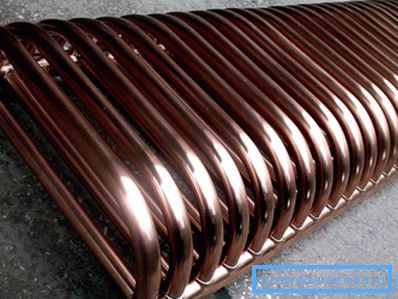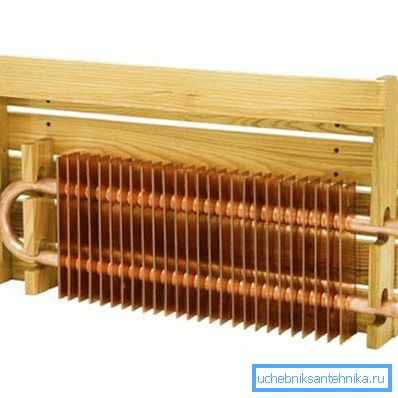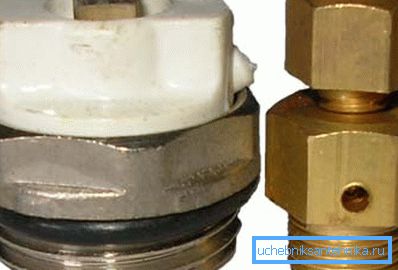Copper heating radiators: features, specifications and
One of the important elements of a space heating system is a heating radiator. It depends on him how quickly and efficiently the house will be heated, and how much fuel will be needed to maintain a comfortable microclimate in an apartment or house. The largest heat conductivity, high efficiency and unsurpassed appearance is distinguished by a copper radiator.
That he is the hero of today's material.

Principle of operation of radiators
The scheme of operation of radiators, which are part of a heating system with a heat-transfer fluid, is extremely simple. Hot water heated by a gas, solid fuel or electric boiler through pipelines enters the battery, where it transfers the accumulated heat energy to the air in the room.
Given this, it is easy to understand that the temperature in a room depends not only on the degree of heating of the fluid and the speed of its flow through the system, but also on the type and material of the radiators used.
From the point of view of physics, heat transfer in heating panels is as follows:
- Water, passing through the radiator, heats the material from which it is made. After that, aluminum, copper or steel begin to emit infrared waves, which, as is well known, are capable of transmitting thermal energy to air molecules.
- The air masses that are heated directly near the battery become less dense and lighter, so they rise to the upper part of the room, giving way to cold air. In the future, this process, which is called convection, is cyclically repeated.
- The ability of heated bodies to emit most of the energy in the form of infrared waves is called heat conduction. The larger this parameter, the more efficiently the radiator will work and the cozier it will be in a heated room in winter.

Note! Copper has the highest thermal conductivity among all materials used to make batteries. Therefore, it is the copper radiators for heating that most efficiently use the energy of the coolant. However, their price is much higher than any other products.
Characteristics of copper batteries
Benefits
Copper batteries occupy a leading position in efficiency, leaving far behind all other existing models, including bimetallic radiators.
Indeed, in addition to this indicator, they have many other undeniable advantages:
- high efficiency - in this parameter, copper overruns widespread cast iron more than 5 times;
- antiseptic - the special properties of non-ferrous metal prevent the growth of microorganisms in the heating system, which can cause harm to a person and become a source of dangerous diseases;

- strength and flexibility - the combination of these two qualities makes it possible to use copper batteries in heating systems without fear of their destruction from hydraulic or pneumatic impact, as well as to easily install products into the constructed engineering network;
- ability to withstand high pressure - copper can be operated in heating systems, where the pressure of the coolant reaches 16 atmospheres, which is much higher than necessary;
- the possibility of using high-temperature coolant - batteries can be operated even at water temperatures in excess of + 140 degrees Celsius.

Note! Copper radiator heater resistant to chemically active fluids. Therefore, with such batteries, you can use antifreeze, which replaces water. The main thing is to choose the right pipelines and fittings.
Special features
The raw material for the production of copper radiators of heating is high-quality copper without any impurities, because in addition to excellent technical characteristics, they have an attractive appearance.
One of the important advantages of the described products is that they do not need to be painted. After all, the paint layer applied on the surface of the heaters reduces the heat transfer coefficient.

Copper batteries do not need a decorative coating. They are either an independent element of the room design or can be equipped with decorative grids that improve the convection of heated air masses.
Not so long ago, special copper plates began to be used, which were simply soldered to the heating pipes, increasing the area of contact with air. As a result, you get the largest battery possible (its size depends only on your desire and the length of the pipes), which usefully uses every watt of energy generated by the boiler.

The greatest effect can be achieved using automatic thermostats that control the operation of the climate network. Thanks to them, a comfortable temperature in the room is achieved and the used heat carriers are saved - gas, electricity, diesel fuel, and so on.
Tips for choosing
If you decide to use copper radiators for installation of the climate network in an apartment or house, you must consider the following nuances:
- It is impossible to combine products from different materials in one system. When installing copper panels, it is necessary to construct pipes from this metal, otherwise a chemical reaction will occur that will lead to corrosion of individual elements of the heating network.
It is also important to take into account the different coefficient of linear expansion as a result of heating.
- Connecting elements - fittings - should not be made of carbon steel, but of non-ferrous metal (for example, brass).

- The heat carrier must be completely cleaned of solid particles that can serve as an abrasive.. Copper is a soft metal and therefore is destroyed as a result of their impact. In addition, control the chemical composition of the liquid: it should not contain acids and alkalis.
The inlet pipe through which the heating is filled must be supplied with a filter.
- Buy components only from trusted vendors. Otherwise, there is a danger to buy batteries made from poor-quality raw materials, which can lead to breakage during the operation of the designed heating network.
Note! In some retail outlets, you can stumble on fakes: a radiator made of low-grade carbon steel is coated with a thin layer of attractive-looking high-quality copper. Be careful, use the services of consultants who know how to check the quality of copper batteries.
Before purchasing it is also necessary to clarify:
- the area of rooms that need to be heated;
- height from floor to ceiling;
- the number and dimensions of door and window openings, the material of the installed window blocks;
- the temperature that must be maintained in the room (for example, in the nursery, it should be more, in the living room or kitchen - less).
As already mentioned, copper has a high heat transfer coefficient, so you can install fewer sections than when choosing batteries made of cast iron or steel.
Installation of copper radiators
Consider the installation of copper batteries with their own hands. The instruction will help you to correctly perform all the necessary actions.
The primary task is to choose the right place. It is recommended to install radiators under window openings, as it is through them that cold air enters the room. Working batteries, on the contrary, create a thermal curtain that heats the room and prevents condensation of moisture on the window glass.
The distance between the bottom edge and the floor, as well as the upper part and the battery should be at least 15 centimeters. Thanks to these gaps, efficient convection of cold and heated air is organized. For the same reason, the battery should be fixed at least 5 cm from the wall.
The installation itself can be done in two ways:
- Using wall mounts. For this purpose, holes are drilled in the wall, in which special hooks are fixed with the help of anchor bolts. Their number depends on the size of the battery. As a rule, 2-5 pieces are enough.

- On legs. In this case, a platform is needed, which is installed on legs about 12 cm long. It serves as a support for the lower edge of the radiator.
Tip! It is desirable to protect the places of contact of fasteners with the copper surface of the radiator with rubber or silicone gaskets. Otherwise, hooks or legs can damage a soft colored metal and cause leakage.

In addition, the installation of copper radiators will require the following equipment:
- Valves for air bleeding from radiators (Mayevsky cranes). They are installed in the upper part of the battery and serve to remove air plugs, which are formed after the heating system is filled with coolant.

- Valves (valves). Put on the inlet and outlet radiator. They allow you to adjust the amount of coolant supplied to the radiator and, accordingly, the temperature in the room. In addition, by blocking these taps, it is possible to easily repair a broken or replace a completely failed element of the heating network.
- Bypass. It is used only in one-pipe heating systems. Connects the incoming and outgoing pipes, bypassing the radiator.

Must be equipped with a crane and have a smaller section than the supply pipe. Allows for more uniform circulation of the coolant.
After installation of all radiators and their joining with pipelines it is necessary to carry out a trial start of heating. To do this, the system is filled with coolant with a minimum pressure and the boiler is turned on.
It is necessary to inspect all joints for leaks. In case of detection of the latter, you need to re-assemble the problem node. At the end of the checks, the system is ready for further operation.
Note! If the radiators are part of the overall heating system (in a city apartment), you need to obtain a document from the housing department employees authorizing the operation of the system. This will protect you from claims in case of pipeline breaks, as the quality of the assembly has been verified by experts.

In a private house, no documents need to be taken. It is advisable only to contact the organization that installs the boiler so that its specialists check the mounted heating network for compliance with the parameters specified in the technical documentation.
Conclusion
Copper radiators of the heating system are one of the best, but also the most expensive, solutions for arranging the heating system of a dwelling. However, the quality of work of the finished climate network and its durability directly depend on the correct installation.
You can learn more about this in the video below.